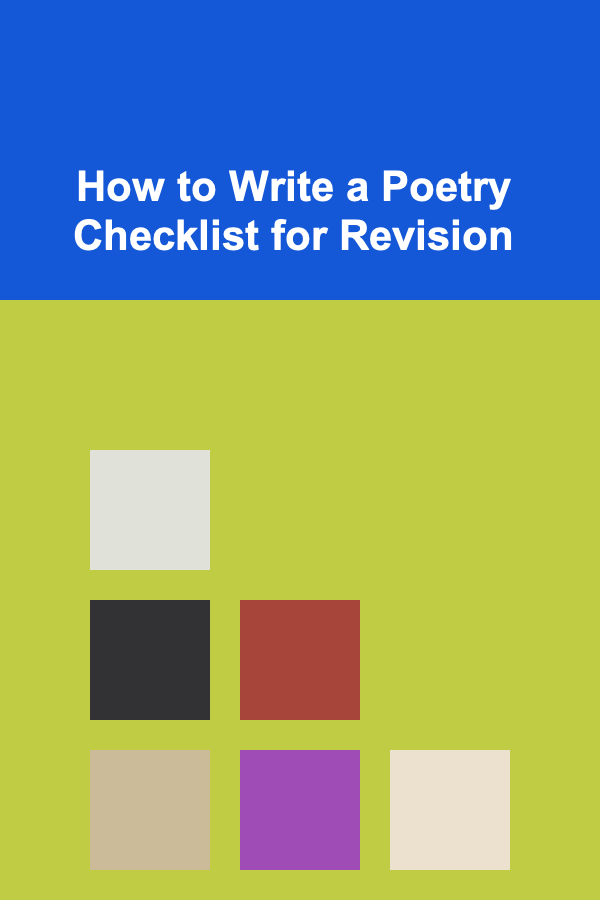
How to Write a Poetry Checklist for Revision
ebook include PDF & Audio bundle (Micro Guide)
$12.99$7.99
Limited Time Offer! Order within the next:

Poetry, as an art form, thrives on the creative expression of emotions, imagery, and the play of language. However, even the most spontaneous and raw poems require careful revision to ensure that every word, line, and stanza achieves its fullest potential. Writing poetry is as much about the process of refining and editing as it is about the initial act of creation. Revision is a crucial part of making sure your poem resonates with the reader, conveys the intended meaning, and evokes the desired emotional response.
Creating a poetry checklist for revision is a valuable tool for any poet, whether they are just beginning or have been writing for years. A checklist allows you to focus your revision process, ensuring that no aspect of the poem is overlooked. In this article, we will explore how to create an effective poetry checklist for revision, discuss the components to consider when revising a poem, and provide practical tips to help you enhance your poetic work.
Understanding the Purpose of Revision in Poetry
Before diving into the checklist itself, it's essential to understand the role of revision in poetry. Writing a poem is a dynamic and evolving process. The first draft is often an exploration of ideas, feelings, and imagery, but the final draft will be a polished piece of art. Revision is where you refine your poem's structure, language, rhythm, and tone, ensuring that every element serves the poem's purpose.
Revision in poetry is not merely about fixing grammatical errors or eliminating clichés (though those are important too). It's about reshaping the poem so that its language feels fresh, its images are vivid, and its rhythm and meter work in harmony with the emotions being conveyed. Often, a poem will go through several rounds of revision before it is ready for publication or performance.
The Essential Elements to Include in a Poetry Revision Checklist
When crafting a poetry checklist for revision, you want to ensure it covers both the technical and artistic aspects of the poem. Below, we will break down key components to include in your checklist and provide specific considerations for each.
1. Overall Structure and Form
The structure of a poem plays a pivotal role in how the reader experiences it. Whether the poem follows a strict form (e.g., sonnet, villanelle) or is free verse, its organization should contribute to its meaning and flow. As you revise, ask yourself the following questions about structure and form:
- Does the structure align with the poem's theme?
- A poem's structure can reinforce its theme. For instance, a tightly controlled form might enhance a theme of confinement or restriction, while free verse could emphasize freedom or fluidity.
- Is the stanza length consistent, or does it vary intentionally?
- The stanza length should contribute to the pacing of the poem. Stanzas that are too long can overwhelm the reader, while very short stanzas can create abrupt pauses.
- Are line breaks and enjambments used effectively?
- Line breaks and enjambments are powerful tools in poetry that affect rhythm and meaning. Ask yourself whether the line breaks contribute to the pacing, whether they create surprise or emphasis, and if they guide the reader through the poem's flow.
- Does the poem adhere to its intended form (if any)?
- If you're writing a poem in a specific form, such as a sonnet, haiku, or limerick, ensure that you have adhered to its rules. Check rhyme schemes, syllable count, and other form-specific elements.
2. Language and Word Choice
The language of a poem is its lifeblood. Every word should serve a purpose, whether to evoke a feeling, create an image, or convey an idea. As you revise, consider the following:
- Is each word necessary?
- Are you using words that add meaning, or are there redundancies? Poets often find that trimming excess words leads to a more concise and impactful poem.
- Is the language clear, or is it overly complex?
- Poetry often thrives on ambiguity and layers of meaning, but clarity is still crucial. Make sure that the language you use communicates the desired message without losing the reader.
- Does the diction suit the tone of the poem?
- The choice of words should reflect the tone of the poem. For example, a poem with a somber tone may benefit from more formal, subdued language, while a playful poem might use more informal or whimsical language.
- Have you avoided clichés?
- Clichés weaken the impact of a poem. Challenge yourself to find fresh, original ways to express common ideas or emotions.
3. Imagery and Metaphors
Imagery is one of the most powerful tools a poet has to create an emotional connection with the reader. Vivid, sensory language draws readers into the poem's world. Consider the following when revising your poem's imagery:
- Are the images clear and vivid?
- Ensure that the imagery in your poem is tangible and evokes strong mental pictures. Avoid abstract or overly vague images.
- Do the images connect to the theme of the poem?
- Every image should serve the poem's central idea or feeling. Check that your images are not random or disconnected but instead contribute to the poem's overall meaning.
- Have you used metaphors and similes effectively?
- Metaphors and similes are often used in poetry to create connections between disparate ideas. Ask yourself if the comparisons are original and whether they enhance the meaning or emotion of the poem.
- Are the sensory details appropriate and balanced?
- Sensory imagery---sights, sounds, smells, tastes, and tactile sensations---can enrich a poem. However, be mindful not to overwhelm the reader with too many details. Select those that are most evocative and meaningful.
4. Rhythm, Meter, and Sound
The sound of a poem is just as important as its meaning. The rhythm and meter help create a musical quality that can either reinforce or contrast with the poem's content. When revising for sound, consider the following:
- Is the poem's rhythm consistent?
- If your poem has a regular meter, ensure that it is consistent throughout, unless intentional deviations are used to create emphasis. A sudden change in rhythm can be jarring if not handled skillfully.
- Are you making effective use of sound devices?
- Devices like alliteration, assonance, consonance, and onomatopoeia can add musicality to your poem. Review whether these devices are used purposefully or if they feel forced.
- Does the rhyme scheme (if any) feel natural?
- If your poem includes rhyme, ensure that it doesn't sound artificial or contrived. The rhyming words should flow naturally within the lines and not detract from the poem's meaning.
- Does the poem have a pleasing sound overall?
- Read the poem aloud during the revision process. Pay attention to how the poem sounds. Is there a pleasing flow to the language? Are the line breaks enhancing or disrupting the sound?
5. Tone and Voice
The tone of a poem is the attitude it conveys towards the subject matter, while the voice is the unique perspective of the poet. Both tone and voice shape how the reader interprets the poem. Consider the following:
- Is the tone appropriate for the subject?
- The tone should match the poem's subject matter. A poem about grief might have a somber, reflective tone, while a poem about joy might feel lighter and more exuberant.
- Does the voice feel authentic?
- The voice should be distinct and genuine, allowing the poet's personality and perspective to shine through. Ensure that the voice remains consistent throughout the poem.
- Is the emotional impact strong enough?
- Does the tone evoke the intended emotions in the reader? Consider whether the emotional register is clear and powerful or whether it needs to be adjusted for greater effect.
6. Pacing and Flow
The pacing of a poem determines how the reader experiences its movement, and it can greatly influence the poem's impact. As you revise, think about the following:
- Does the pacing build or release tension appropriately?
- Pacing can create suspense, surprise, or resolution in a poem. Look at how your poem unfolds---are there moments of tension followed by release? Or is the poem too predictable?
- Do the line breaks and stanza structure affect the flow?
- Pay attention to how the arrangement of stanzas and line breaks shapes the poem's rhythm and pacing. You can manipulate pacing through strategic use of enjambment or end-stopped lines.
- Is there a balance between fast and slow moments?
- A poem should have moments of acceleration (short, rapid-fire lines) and moments of slowing down (longer, more contemplative lines). This balance keeps the poem dynamic.
7. Conclusion and Final Touches
After addressing all of the technical elements, take a step back and evaluate the poem as a whole. Ask yourself the following:
- Does the poem achieve its purpose?
- Reflect on the original intention behind the poem. Has it successfully communicated the emotions, ideas, or images you aimed to convey? Does it resonate with the reader on an emotional or intellectual level?
- Is the poem as concise and focused as possible?
- Finally, ensure that the poem is as tight and clear as it can be. Trim unnecessary words, remove redundancies, and ensure that every line contributes to the whole.
Once you feel confident with your revisions, take a final look at your poem. Read it aloud one last time to make sure the rhythm flows smoothly, the tone is consistent, and the emotional impact is as strong as it can be. This is the moment where your poem transforms from a draft into a finished piece of art.
Conclusion
Writing and revising poetry is a delicate balance of technical skills and artistic intuition. By following a structured checklist during revision, you ensure that your poem is refined in every aspect---structure, language, imagery, rhythm, and tone. Whether you are revising your first poem or your hundredth, a poetry checklist helps you focus on the essential elements that make poetry compelling and resonant. Remember that revision is an ongoing process of discovery and refinement, and each round brings your poem one step closer to its ideal form.
Reading More From Our Other Websites
- [Home Budget 101] How to Budget for Home Repairs and Avoid Financial Stress
- [Home Renovating 101] How to Design an Open Floor Plan for Your Home
- [Home Staging 101] How to Stage a Small Apartment to Make It Feel Bigger and Brighter
- [Reading Habit Tip 101] Tech Tools for Faster Reading: Apps, Extensions, and Readers That Work
- [Home Family Activity 101] How to Create a Family Bucket List for Winter Adventures
- [Screen Printing Tip 101] DIY Guide: Setting Up a Home Studio for Professional-Quality Screen Prints
- [Organization Tip 101] How to Maximize Space in a Small Family Room
- [Ziplining Tip 101] Best Virtual Reality Ziplining Simulators for Planning Real-World Trips
- [Home Security 101] How to Create a Home Safety Checklist for Better Protection
- [Personal Finance Management 101] How to Improve Your Credit Utilization Ratio for a Healthier Credit Score

How to Choose and Install High-Quality Kitchen Cabinets
Read More
How to Host a Progressive Dinner Party with Friends
Read More
How to Use Antique Catalogs for Reference and Organization
Read More
Step-by-Step Guide to Crafting Beautiful DIY Gifts and Cards
Read More
How To Master Video Compression
Read More
10 Tips for Navigating Mercury Retrograde Season
Read MoreOther Products

How to Choose and Install High-Quality Kitchen Cabinets
Read More
How to Host a Progressive Dinner Party with Friends
Read More
How to Use Antique Catalogs for Reference and Organization
Read More
Step-by-Step Guide to Crafting Beautiful DIY Gifts and Cards
Read More
How To Master Video Compression
Read More